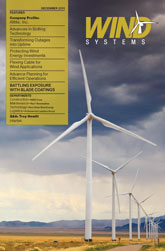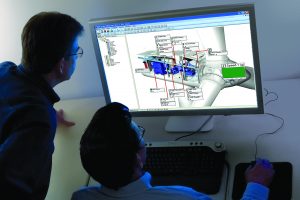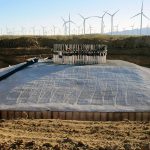In the October installment of this column we discussed various ways to prepare the wind turbine for winter operations. We continue our conversation by addressing the safety risks related to cold weather and how advance planning, and training, can avoid cold weather related injuries to the service team.
Most technicians know how standing for long periods on sub-zero steel deck plating can suck the heat right out of you. Not surprisingly, even an operator in sunny southern California will complain about the cold weather in January. For his counterpart in the Midwest, such highs in the fifties would be a welcome feeling where average temperatures can hover in the teens for weeks on end. Working outdoors in such conditions is not to be taken lightly. As part of any winter service preparation, refresher training in recognizing the effects and avoidance of hypothermia and frostbite should be high on the list before winter settles in. For an unprepared technician, the onset of hypothermia can be gradual over time and is often caused by working in cold weather with inadequately insulated clothing. Since there is no exact temperature where the environment becomes hazardous, technicians need to be prepared against a variety of weather conditions including wind, dampness, rain and snow. As part of the seasonal training, employers should encourage the use of layered clothing by their technicians; cotton on the inner layer to wick away perspiration, followed by wool or synthetics to retain body heat and an outside layer to shield from wind and moisture. The wind can quickly carry heat away from the body, and clothing that protects the body from its effect should be part of the winter gear that includes helmet liners, insulated gloves, and boots. A balance in maintaining the mobility of a technician must be considered as well, as cold weather clothing can inhibit dexterity. Gloved hands make it more difficult to manipulate controls and tools, and heavy garments make ordinary movement more difficult.
Technicians should understand that while it might feel easier to climb a tower in 30-degree weather as opposed to during a 90-degree day, their level of exertion hasn’t changed. In fact, exertion in cold weather imposes significant factors that deceptively alter the body’s ability to self-regulate hydration without the aid of insulated clothing or intake of additional fluids. Most people don’t feel as thirsty when it’s cold, and they drink less. This is because blood flow moves from the extremities to the body core and the fluid level in the central body remains elevated, thereby reducing the thirst response. Educating the field teams to increase their fluid intake during the winter months is essential to prevent dehydration caused by exertion. Since cold climates tend to be less humid, working in such conditions can cause significant water loss through the skin and lungs as a result of the dryness of the air.
Traversing in deep snow can also present both an issue of immense exertion and a very real hazard from the moisture it leaves after melting from body heat. Blowing snow will find its way not only into a breeched nacelle, but also into any crack or opening in cold weather clothing. Snow weighs on average between 5-10 pounds per cubic feet, and while this may not seem like much, manual shoveling is usually required to keep pathways clear and often to gain tower access for maintenance. Recognizing that more heart attacks occur in cold weather than in warm weather, technicians should be aware of their own capabilities and take frequent rests during such intense physical activity. The reason? Regardless of the level of health, very cold temperatures cause an increase in blood pressure and a better chance for blood clots.
Lack of acclimatization actually predisposes an individual to the cold stresses of hypothermia or frostbite. Working safely in cold weather means allowing short interval exposure until the individual becomes acclimated to working outdoors in low temperatures. Though it may not always be convenient for the service of a wind project, scheduling outdoor work during the warmest time of the day is a good safety policy during the winter months. Allowing frequent breaks in heated shelters and reducing the daily work pace may sound counterproductive, but the benefit will show itself in reduced cold-related injuries on the job.
Environmental factors in winter working conditions create the real possibility that cold related injuries may occur. Alongside appropriate work policies, technicians should be trained to recognize hazardous conditions and be made aware of the appropriate weather gear needed to protect them. With the proper training, safe work practices, and the right gear, outdoor work in cold weather can be safe and productive.



































